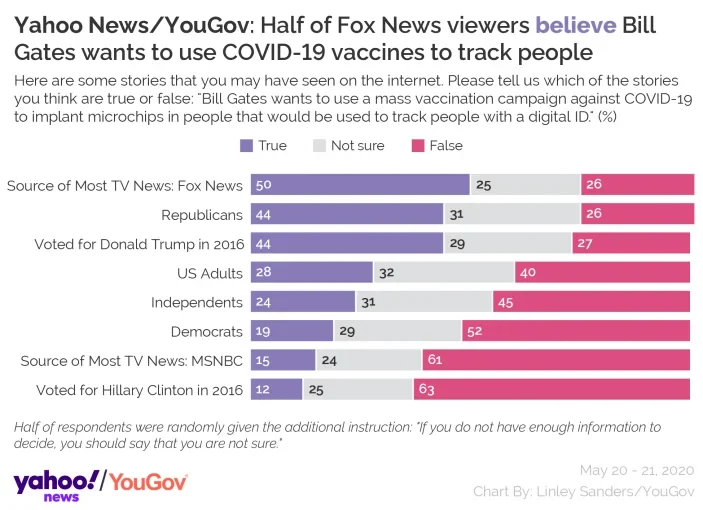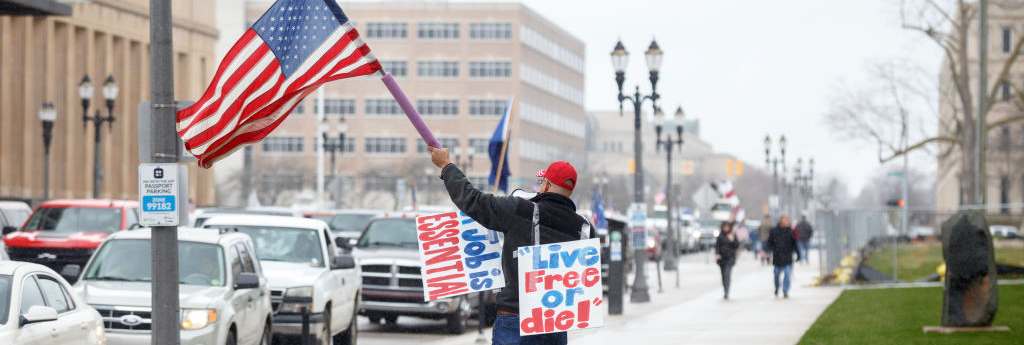This poll is a part of the Yahoo News/YouGov partnership and was cited in the Yahoo News article “New Yahoo News/YouGov poll shows coronavirus conspiracy theories spreading on the right may hamper vaccine efforts”
As the coronavirus has spread across the United States, so has rampant misinformation about the illness. A new poll from Yahoo News/YouGov asked about some of the more prevalent Internet theories that have little or no basis in fact, and the results show some strong partisan divides.
Most Republicans (57%), for instance, believe a widespread myth that Chinese scientists engineered the coronavirus in a laboratory in Wuhan, China, from where it accidentally escaped. About one-quarter of Democrats (23%) think this is true, and most (53%) believe it is false.
A plurality of Republicans (44%) also believes a claim that appears to have originated on Facebook: that Microsoft founder Bill Gates wants to use a mass vaccination campaign against COVID-19 to implant microchips in people that would be used to track people with a digital ID. The post was removed by Facebook as an attempt to halt the spread of misinformation.
Despite that, half of Americans who watch Fox News as their primary news source (50%) indicated that they believe the statement about Gates is true. In contrast, most Americans who cite MSNBC as their primary source of TV news (61%) believe the statement is false.

Republicans (50%) are also much more likely than Democrats (20%) to believe an incorrect claim that repeated by President Donald Trump: that the United States has conducted more coronavirus tests than the rest of the world combined.
In fact, the Yahoo News/YouGov poll shows that Republicans and Democrats are sharply divided on how Trump addressed the COVID-19 outbreak when it began spreading across America.
Nearly three-quarters of Democrats (73%) believe the commander-in-chief called the coronavirus a hoax. A plurality of Republicans (42%) say that’s not true. A misleading video that appears to show President Trump calling the disease itself a hoax has been widely circulated by a pro-Biden PAC — but the fact-checking website PolitiFact calls it highly misleading. In reality, the video was edited to make it appear that Trump is calling the disease itself a hoax.
About half of GOPers (51%) believe that Trump always viewed the coronavirus as a very serious threat (in January, he said COVID-19 was “well under control.”) About half (52%) of Republicans also believe the COVID-19 pandemic was something nobody thought could happen. A CNN fact-check indicates that public health experts and officials in the Trump administration “warned for years that the country was at risk from a pandemic.”
Democrats are more likely than Republicans to believe that coronavirus-related deaths have surged in states like Florida, Georgia, and Texas which have reopened their economies. That was also the story most-likely to be believed by Americans overall (45% believed it was true, compared to 26% who say it is false). The data indicates that coronavirus-related deaths have been declining in Florida and Georgia, but increased this past week in Texas. Experts have warned that there could still be a second-wave of coronavirus outbreaks in states that re-open too quickly.
Related: Becoming a coronavirus contact tracer intrigues those whose employment was impacted by COVID-19
See the toplines and crosstabs from this week’s Yahoo News/YouGov Poll
Methodology: The Yahoo News survey was conducted by YouGov using a nationally representative sample of 1,640 U.S. adult residents interviewed online between May 20 and 21, 2020. This sample was weighted according to gender, age, race and education, as well as 2016 presidential vote, registration status, and news interest. Respondents were selected from YouGov’s opt-in panel to be representative of all US residents. The margin of error is approximately 3.0 percent.
Image: Getty












